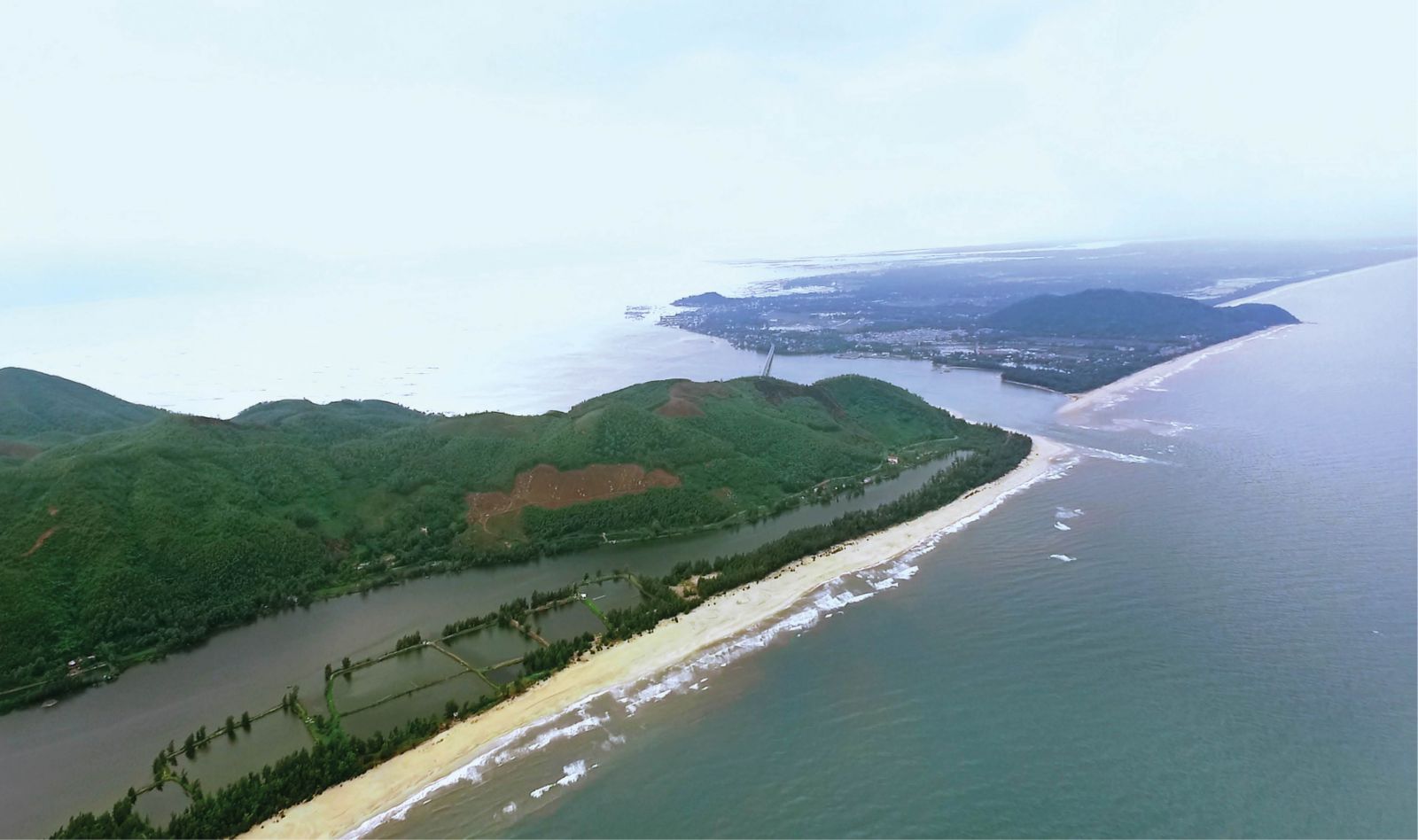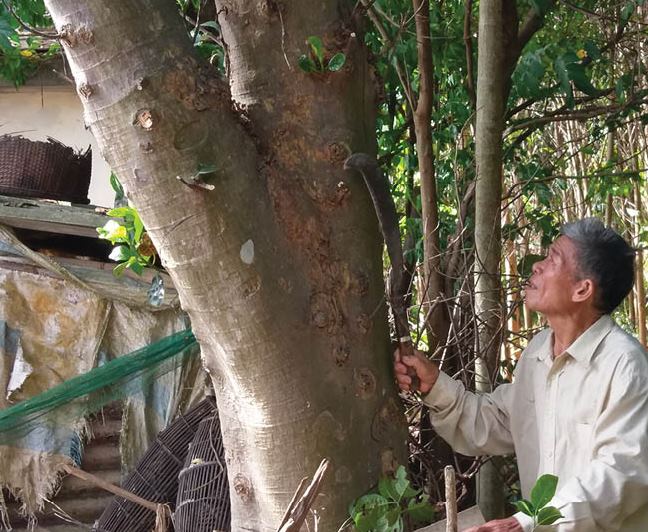
Loc Binh has many advantages for socio-economic development. Photo: Duy Duong
Conquering the wild
The National Highway 49B runs through Loc Binh commune, stretching across the vast acacia and cajeput plantations, on where the footprints of the forest farmers from the reclamation period are deeply carved.
Advised by the Deputy Secretary of the Party Committee of Loc Binh Commune Mr. Le Duc Phuong, we paid a visit to the old farmer Mr. Huynh Van Thanh (79 years old, Hoa An hamlet). It was already past noon when we arrived at his house. With a bush hook and a bottle of water on his shoulders, he leisurely walked down from the forest behind his house. His blood and flesh have been ‘blended’ with every inch of forest land in this rocky mountainous area.
At the age of 79, he still looks admirably sturdy. He said: “I am 79 years old already. My life will be over as soon as I hang this bush hook up. But the love for the forest and this land still burns within me, urging me to germinate more green buds to this rocky mountain.”
His miracle story of thriving on the mountain started after the Liberation in 1975, during the resettlement of people from Vinh Hien commune (Phu Loc) to Loc Binh to reclaim land for afforestation. The word “afforestation” may be an exaggeration as in the beginning the first settlers mostly collected firewood and transported them to lowland areas to exchange for rice since Vinh Hien area offer no land for wet rice cultivation.
1989 was the year that Mr. Thanh's first footsteps imprinted on the Hong Ram mountain. Some of the poplar and gum trees he first planted following the “Planting trees in memory of Uncle Ho” campaign are still there, serving as “living witnesses” of the reclamation period.
Planting forests is an arduous task, and much more so with planting forests on rocky mountain. After the historic flood in 1999, with the backing from local authorities, he started his acacia mangium and earleaf acacia plantation. Countless were the difficulties that he encountered when paving the way up to the mountain.
“At that time, there were no machines, and the Hong Ram mountain area was vast, yet we - the forest farmers here still restlessly carried seedlings and meals climbing up the mountain to dig up rocks in search of ... soil. We planted trees at every inch of soil we could find. In places covered with rocks, the rocky surface had to be chiseled to enable the planting. Back then, labor cost was low, but I didn't have money to hire people, so the work had to be done by the members in the family,” shared Mr. Thanh.
For years, he carried seedlings to the mountain at dusk, worked hard and didn’t come home until the sun had set, when one couldn’t even see one’s hands. As a reward for his dedication, the first young trees took root on the vast mountain. Later, he switched to acacia hybrid and cajeput. The upgrade to the National Highway 49B has also made it easier for trucks to come for forest harvesting.
Unlike Mr. Thanh, Mr. Huynh Kiem (67 years old, Hoa An hamlet) started his miracle not in thriving on the mountain but on black tiger shrimps. It was the year 1999, when he managed to borrow 50 million VND to invest into bulldozing nearly 1 acre of lagoon land to build up a shrimp farm. It was commonly held at that time that "a shrimp is as valuable as a basket of rice". However, only the first harvest enjoyed a fairly success. After that, due to water pollution, failure went after failure.
After a typhoon, all his efforts and investment into shrimp farming were swept to the sea. One morning, looking at his devastated shrimp farm, he made his mind: "If the sea doesn’t serve me, maybe the forest will!"
In 2000, he asked local authorities for permission and then started to reclaim the land behind his house to grow the first acacia seedlings. At that time, the roads were in bad condition, so every day he could only backpack from 150 to 200 seedlings up to the mountain and find places to plant them.
Short of money, he had to borrow from different sources to hire workers, at the rate of VND 40,000 per day, to clear the bushes to start his plantation. After years of human work, the mountainous area of Thung Ca was more tamed. It was the right time for Mr. Kiem to hire an excavator to open the first roads to ship his wood to downtown.

Mr. Huynh Van Thanh taking care of his garden. Photo: Ha Nguyen
Forest is the right choice
After a long trip of hardship, Mr. Thanh and Mr. Kiem now each own from 10 to 15 hectares of acacia and cajuput plantation, covering immense areas of the rocky mountain. The forests have given their family a secure livelihood, allowing them to afford and sustain their children’s education. Nowadays, forest work for them is not only to earn a living but also a passion.
"Now, after many years seeking livelihood in the forest, I feel I made the right choice… When I moved from Vinh Hien to here, I had my wife and four children dependent on me. No one would have thought I would be able to provide all my children through all the hardship,” said Mr. Thanh. From the 10 hectares of forest that he now possesses (not to mention the areas that he co-invests with other households), only income from year-round harvesting is sufficient to cover daily expenses and put into renovating his house.
The forest work and frequent harvests have not only kept Mr. Thanh’s family employed but also provided them with a stable source of income. Taking advantage of the large area of land that has been reclaimed, he has also grown other different kinds of fruit trees on the hills and around his garden as well as raised poultry. Each year, Mr. Thanh's family earns about VND 80 million on average.
On top of the 15 hectares of acacia and cajuput in the mountainous area of Thung Ca, which yield an annual income of about VND 50 million per hectare, Mr. Huynh Kiem's family has also invested in planting 200 agarwood trees and a small pepper farm, which have been put into exploitation. Agarwood trees in Loc Binh grow slowly, but the barren land on which they grow allows better aromatic quality.
To teach himself, he went to the Forest Protection Unit of Phu Loc District to ask for materials about forest cultivation and then started to plant several thousands of acacia seedlings to sell to the households in need in the commune. To build up on his family’s economy, Mr. Kiem and his wife also cultivate wet rice. Thanks to the forest and his steadfastness in working with it, he has been able to provide his six children’s education and to build a nice and spacious house.
According to Mr. Le Duc Phuong, Deputy Secretary of Loc Binh Commune Party Committee, forest planting in Loc Binh cannot compete with other places in terms of production or economy. And unlike other places, there are no forest “tycoons” here, since those with the most forest areas have only from 10 to 15 hectares. However, having a slot of land and a stable income in such a coastal and lagoon area like Loc Binh is for sure a dream that many forest workers have been pursuing.
By Ha Nguyen